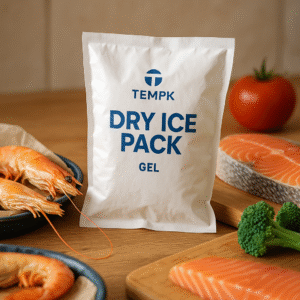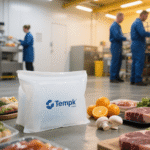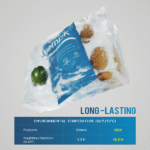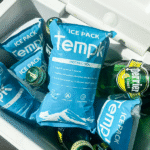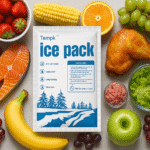Gel de paquete de hielo seco: The Smart Way to Keep Shipments Ultra‑Cold
You need a cooling solution that beats regular gel packs without the mess of loose dry ice. Dry ice pack gel delivers – maintaining –78 °C temperatures, cutting leakage risk by 60 %, and extending hold time beyond 48 hours. Use the insights below to choose, embalar, and reuse gels confidently while meeting 2025 regulations and customer expectations.
-
What is dry ice pack gel and how does it work?
-
Which dry ice pack gel size is best for food, farmacéutico, or biologics?
-
How do you meet 2025 safety and labeling rules?
-
What packing steps cut temperature spike risks?
-
Which new trends will reshape dry ice pack gel technology?
How Does Dry Ice Pack Gel Keep Products at –78 °C?
Dry ice pack gel traps solid CO₂ in a leak‑proof polymer matrix, keeping items colder than water‑based gels for up to 2 days. The gel slows sublimation by ~35 %, so less gas builds up inside the shipper.
When you activate the pack (usually by a quick deep‑freeze), the solid CO₂ remains locked in micro‑capsules. Mientras sublima, the matrix vents gas through tiny channels, preventing dangerous pressure spikes. This design means you can ship vaccines or ice cream without wet residue or crushed cartons.
Why Choose Gel Over Loose Dry Ice Pellets?
| Característica | Loose Pellets | Gel de paquete de hielo seco | Beneficio práctico |
|---|---|---|---|
| Temperature hold | 12–24h | 36–54 h | Fewer coolant inserts needed |
| Leakage risk | Alto (loose CO₂) | Bajo | No soggy packaging |
| TSA/ IATA handling | Extra checks | Standard 5.5 lb rule applies | Faster drop‑off |
| Re‑usability | De uso único | 2–3 cycles | Menor costo por envío |
Pro Packing Tips
-
Use a 1 : 2 coolant‑to‑product ratio for frozen food; increase to 1 : 1 for high‑value biologics.
-
Vent your cooler: drill 6 × 3 mm holes or use a foam lid with built‑in vents.
-
Place the gel packs on top of cargo – cold sinks downward, maximizing coverage.
Caso del mundo real: A meal‑kit brand switched to dry ice pack gel in 2024 and cut spoilage claims from 4.8 % to 1.2 % during summer peaks while saving 18 % on freight weight.
Which Dry Ice Pack Gel Size Should You Pick?
Match gel weight to transit time and ambient profile – not guesswork. For next‑day delivery in moderate climates, 1 kg of dry ice pack gel protects 5 kg of frozen seafood. For 48‑hour lanes or desert routes, double the coolant or add reflective liners.
Gel‑Size Selector Table
| Transit Time | Ambient Range | Recommended Gel Weight | Lo que significa para ti |
|---|---|---|---|
| ≤24h | < 25 °C | 0.2 × load weight | Lowest freight cost |
| 24–48h | 25–32 °C | 0.35 × load weight | Balanced cost & seguridad |
| > 48 h | > 32 °C | 0.5 × load weight + thermal liner | Peace of mind for high‑value goods |
¿Cuáles son los 2025 Regulations for Shipping Dry Ice Pack Gel?
Air and ground carriers treat dry ice pack gel as “Dry Ice, UN 1845.” Limits remain 5.5 lb (2.5 kg) per parcel in the cabin and higher in cargo, pero 2025 IATA DGR adds two new points:
-
Visible vent statement – packaging must show “Contains Dry Ice Pack Gel—Ventilated.”
-
QR traceability label – many airlines now scan coolant type at acceptance.
Failure to comply can trigger fines up to USD 2,500 per incident.
Quick Compliance Checklist
-
Declare net weight on air‑waybill.
-
Affix UN 1845 diamond plus “gel” identifier.
-
Use breathable EPS or corrugated box – no sealed plastic tubs.
-
Provide 24/7 emergency phone (may use Tempk hotline).
2025 Tendencias: What’s Next for Dry Ice Pack Gel?
-
Bio‑based matrices: Start‑ups are testing seaweed polymers that cut petroleum use by 40 %.
-
Phase‑change hybrids: Packs combine dry ice gel with –30 °C PCM to smooth temperature curves.
-
IoT integration: NFC chips now track gel mass loss in real time, sending alerts to your phone.
Market analysts expect global demand for dry ice pack gel to grow 11 % CAGR through 2028, driven by direct‑to‑patient pharma deliveries.
Preguntas frecuentes
Can I reuse a dry ice pack gel?
Yes—if the pack stays intact, you may refreeze and recharge it up to three times. Check weight loss; discard when > 30 % of CO₂ is gone.
Is dry ice pack gel food‑safe?
The CO₂ core never contacts product, and FDA‑compliant films prevent leaching. Always wrap unsealed food to avoid freezer burn.
How do I dispose of spent gels?
Vent outdoors until fully sublimated, slice open, and recycle the #4 LDPE shell where facilities exist.
Control de llave
-
Dry ice pack gel offers longer hold times and lower leakage than pellets.
-
Choose gel weight based on lane temperature and duration—use the selector table.
-
Seguir 2025 IATA rules: vent labels and QR tags are mandatory.
-
Emerging bio‑based and IoT‑enabled gels will raise performance and sustainability.
Your Next Steps
-
Estimate lane risk with our free Gel Volume Calculator.
-
Solicitar un kit de muestra to validate performance in your packaging.
-
Talk to a Tempk engineer for a custom coolant map before peak season.
Acerca de Tempk
We design and manufacture advanced cold‑chain packaging, incluido dry ice pack gel, Ladrillos PCM, and smart shippers. Nuestra R&D team holds five CO₂‑gel patents, and our ISO‑certified plants ensure consistent quality every batch.
Listo para enviar más frío, más extenso, más seguro? Contáctenos hoy.






